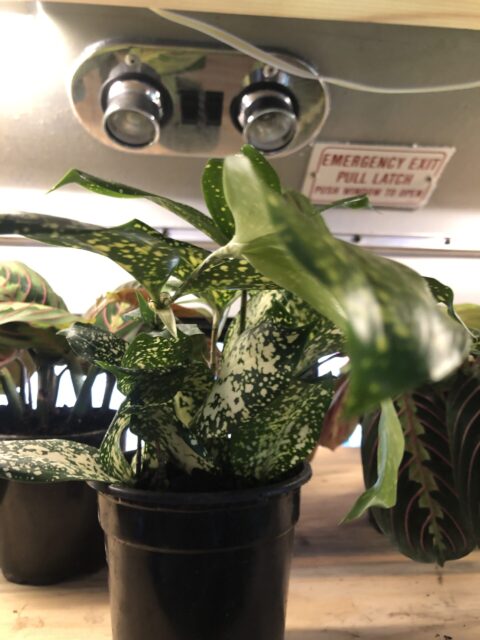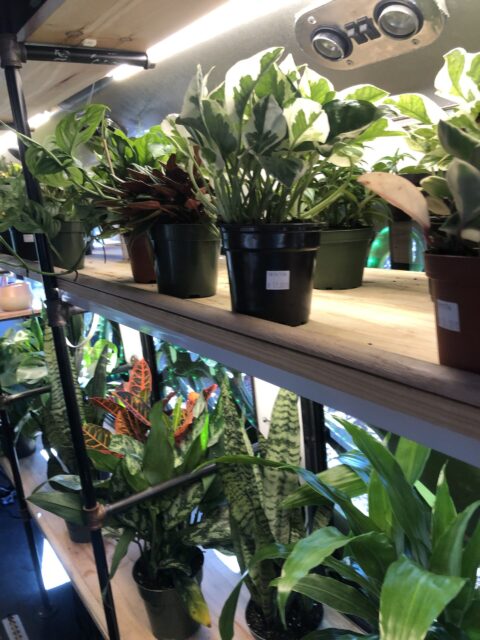“Our lives and actions are not meaningless — in fact, the opposite is true. Our rapidly changing climate proves that we are all connected, that every action we take can alleviate suffering not only tangibly, locally and immediately but across the vast network of life and throughout all time. Our lives and actions may be temporary and imperfect, but by accepting our tiny place in the world, we unlock a deeper way of being. And we help to bring about a future that will be unimaginably better for everyone.”
– Eric Holthaus in The Future Earth: A Radical Vision for What’s Possible in the Age of Warming
Trends tend to be annoying. One that isn’t: the boom in houseplants.
The interest expands into foraging, converting ornamental lawns into useful yards, and undertaking guerrilla gardening projects, but houseplants in particular seem to speak the loudest. They require little space — perfect in a time when securing a mortgage is challenging for or undesirable by many. They don’t require the resolve needed for planting wildflowers in public places without prior permission. While some knowledge is needed, a mistake means damaging the plant — not potentially poisoning oneself, as can happen when eating from unfamiliar wild plants.

It makes sense that in this moment, people are turning their attention to nurturing. The pandemic has no doubt sparked some of this, with people needing a hobby. What is more hopeful than adopting a monstera seedling and watching it in mere weeks sprout more leaves, tripling in size?
At the same time, so much of our world has been either manipulated or moved online. Then, there are the constant wars.
Why wouldn’t people be moved to attempt to alleviate suffering by surrounding themselves with calming and beautifying nature?
A benefit of this trend has been the increased access to plants. For at least the past few decades, in Connecticut anyway, getting plants meant having to trek to a nursery in the suburbs or exurbs — unless you can cycle, these trips basically required a car. Few were or are anywhere near bus service. Or, it would mean a very limited selection of what could be found in a supermarket or other type of Big Box store; there, you had no guarantee of getting advice from employees. Mail order is dicey.
Just in the last few years, Hartford residents have been able to find plants, reliably, at two shops on Pratt Street. That’s mere steps from a major bus stop in downtown. That’s in addition to several pop-up plant shopping events there and elsewhere.

The photos in this post were taken of the Li’l Plant Bus, parked at the Harvest Market on Saturday. It was filled with plants, equipment, gift items, and adorable tiny planters. Two staff provided answers to questions you might not have known you had, including how to safely trim back and propagate from cuttings. That’s information not readily volunteered by some shops. They let you know when is a good time to repot (not now!), how much to water, what amount of light is needed. Everything they were selling looked healthy.
The mobile plant shop expands access by popping up at different events around the state, but the owners also run The Li’l Plant Shop at 8 East Main Street in Plainville. This is a one-minute walk from the nearest bus stop (Plainville Library), which happens to be the CTfastrak 102 route.
Climate Possibilities is a series about climate mitigation, along with resilience, resistance, and restoration. It’s about human habitat preservation. It’s about loving nature and planet Earth, and demanding the kind of change that gives future generations the opportunity for vibrant lives. Doomers will be eaten alive, figuratively. All photographs are taken in Hartford, Connecticut unless stated otherwise.
Plants
“Our lives and actions are not meaningless — in fact, the opposite is true. Our rapidly changing climate proves that we are all connected, that every action we take can alleviate suffering not only tangibly, locally and immediately but across the vast network of life and throughout all time. Our lives and actions may be temporary and imperfect, but by accepting our tiny place in the world, we unlock a deeper way of being. And we help to bring about a future that will be unimaginably better for everyone.”
– Eric Holthaus in The Future Earth: A Radical Vision for What’s Possible in the Age of Warming
Trends tend to be annoying. One that isn’t: the boom in houseplants.
The interest expands into foraging, converting ornamental lawns into useful yards, and undertaking guerrilla gardening projects, but houseplants in particular seem to speak the loudest. They require little space — perfect in a time when securing a mortgage is challenging for or undesirable by many. They don’t require the resolve needed for planting wildflowers in public places without prior permission. While some knowledge is needed, a mistake means damaging the plant — not potentially poisoning oneself, as can happen when eating from unfamiliar wild plants.
It makes sense that in this moment, people are turning their attention to nurturing. The pandemic has no doubt sparked some of this, with people needing a hobby. What is more hopeful than adopting a monstera seedling and watching it in mere weeks sprout more leaves, tripling in size?
At the same time, so much of our world has been either manipulated or moved online. Then, there are the constant wars.
Why wouldn’t people be moved to attempt to alleviate suffering by surrounding themselves with calming and beautifying nature?
A benefit of this trend has been the increased access to plants. For at least the past few decades, in Connecticut anyway, getting plants meant having to trek to a nursery in the suburbs or exurbs — unless you can cycle, these trips basically required a car. Few were or are anywhere near bus service. Or, it would mean a very limited selection of what could be found in a supermarket or other type of Big Box store; there, you had no guarantee of getting advice from employees. Mail order is dicey.
Just in the last few years, Hartford residents have been able to find plants, reliably, at two shops on Pratt Street. That’s mere steps from a major bus stop in downtown. That’s in addition to several pop-up plant shopping events there and elsewhere.
The photos in this post were taken of the Li’l Plant Bus, parked at the Harvest Market on Saturday. It was filled with plants, equipment, gift items, and adorable tiny planters. Two staff provided answers to questions you might not have known you had, including how to safely trim back and propagate from cuttings. That’s information not readily volunteered by some shops. They let you know when is a good time to repot (not now!), how much to water, what amount of light is needed. Everything they were selling looked healthy.
The mobile plant shop expands access by popping up at different events around the state, but the owners also run The Li’l Plant Shop at 8 East Main Street in Plainville. This is a one-minute walk from the nearest bus stop (Plainville Library), which happens to be the CTfastrak 102 route.
Climate Possibilities is a series about climate mitigation, along with resilience, resistance, and restoration. It’s about human habitat preservation. It’s about loving nature and planet Earth, and demanding the kind of change that gives future generations the opportunity for vibrant lives. Doomers will be eaten alive, figuratively. All photographs are taken in Hartford, Connecticut unless stated otherwise.
Related Posts
Sneak Preview
Two Cemeteries After the Storm
In Your Neighborhood: Frog Hollow